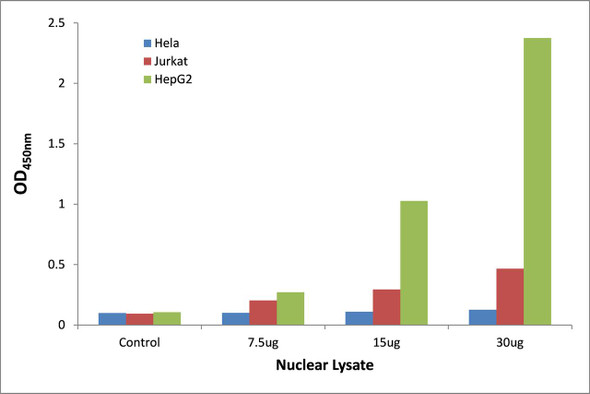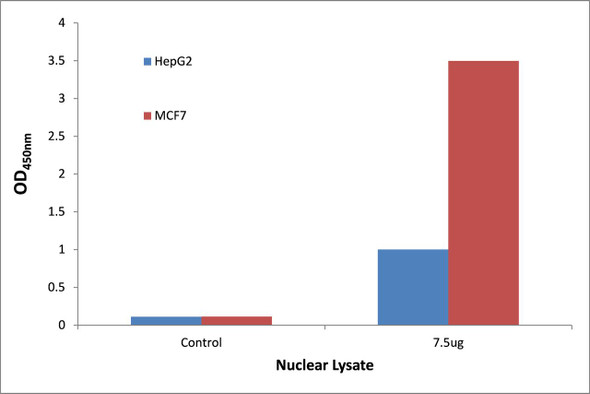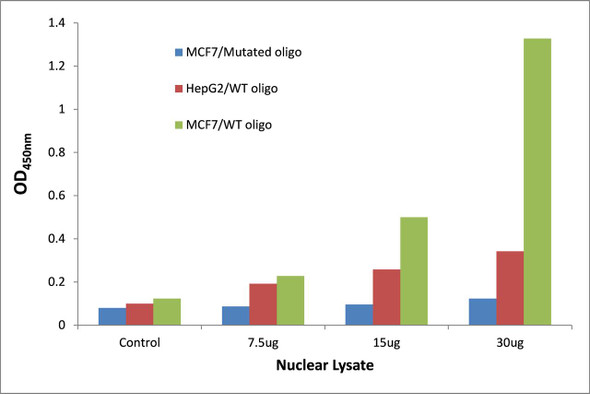Description
system_update_altDatasheet
| Product Name: | E2F-5 Transcription Factor Activity Assay |
| Product Code: | TFAB00092 |
| Target: | E2F-5 |
| Reactivity: | Human, Mouse, Rat |
| Sample Types: | Nuclear or cell lysates |
The Assay Genie E2F-5 transcription factor activity assay allows for the detection and qualitative analysis of endogenous levels of activated transcription factors in a variety of nuclear and cell lysates
Assay Genie ELISA kits are designed to significantly reduce experiment time and ensure sensitivity and flexibility for high-throughput screening.
| Assay Time: | 4.5 hours |
| Detection Method: | Colorimetric 450 nm |
| Size: | 12 x 8-Well Microstrips |
| Storage: | 4°C for 6 months |
| UniProt Protein Function: | E2F5: a member of the E2F/DP family of transcription factors. The E2F family plays a crucial role in the control of cell cycle and action of tumor suppressor proteins and is also a target of the transforming proteins of small DNA tumor viruses. Transcriptional activator that binds to E2F sites, these sites are present in the promoter of many genes whose products are involved in cell proliferation. May mediate growth factor-initiated signal transduction. It is likely involved in the early responses of resting cells to growth factor stimulation. Differentially phosphorylated and is expressed in a wide variety of human tissues. It is more homologous to E2F4 than to other E2F/DP family members. Both this protein and E2F4 interact with tumor suppressor proteins p130 and p107, but not with pRB. |
| UniProt Protein Details: | Protein type:Transcription factor; DNA-binding Chromosomal Location of Human Ortholog: 8q21.2 Cellular Component: nucleolus; nucleoplasm; nucleus Molecular Function:protein binding; transcription factor binding Biological Process: positive regulation of transcription from RNA polymerase II promoter |
| NCBI Summary: | The protein encoded by this gene is a member of the E2F family of transcription factors. The E2F family plays a crucial role in the control of cell cycle and action of tumor suppressor proteins and is also a target of the transforming proteins of small DNA tumor viruses. The E2F proteins contain several evolutionarily conserved domains that are present in most members of the family. These domains include a DNA binding domain, a dimerization domain which determines interaction with the differentiation regulated transcription factor proteins (DP), a transactivation domain enriched in acidic amino acids, and a tumor suppressor protein association domain which is embedded within the transactivation domain. This protein is differentially phosphorylated and is expressed in a wide variety of human tissues. It has higher identity to E2F4 than to other family members. Both this protein and E2F4 interact with tumor suppressor proteins p130 and p107, but not with pRB. Alternative splicing results in multiple variants encoding different isoforms. [provided by RefSeq, Jul 2008] |
| UniProt Code: | Q15329 |
| NCBI GenInfo Identifier: | 2494230 |
| NCBI Gene ID: | 1875 |
| NCBI Accession: | Q15329.1 |
| UniProt Secondary Accession: | Q15329,Q16601, Q92756, E9PBN9, |
| UniProt Related Accession: | Q15329 |
| Molecular Weight: | 20,192 Da |
| NCBI Full Name: | Transcription factor E2F5 |
| NCBI Synonym Full Names: | E2F transcription factor 5 |
| NCBI Official Symbol: | E2F5 |
| NCBI Official Synonym Symbols: | E2F-5 |
| NCBI Protein Information: | transcription factor E2F5 |
| UniProt Protein Name: | Transcription factor E2F5 |
| Protein Family: | Transcription factor |
| UniProt Gene Name: | E2F5 |
| UniProt Entry Name: | E2F5_HUMAN |






